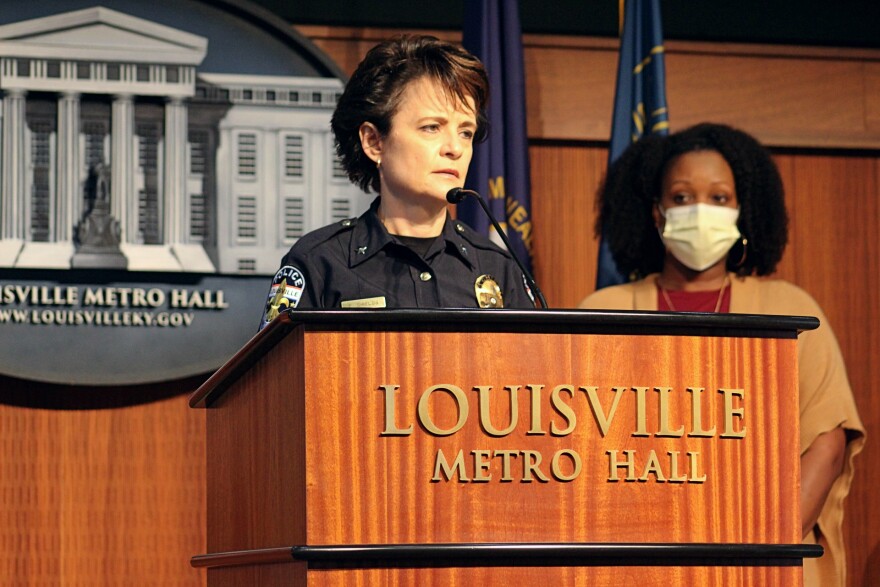Louisville police officials are trying to address the public's concerns after news that nearly 400 law enforcement officers failed to stop a mass shooting in Uvalde, Texas, in May.
Louisville Metro Police Department Chief Erika Shields and members of her leadership team addressed the agency’s capability to respond to the threat of a mass shooting at a meeting of Metro Council’s Public Safety Committee on Wednesday.
Shields told committee members she’s been reviewing the 77-page report released by the Texas House of Representatives on Monday. That report found the police response in Uvalde was plagued by “systemic failures and egregiously poor decision making.”
In light of those failures, Shields said LMPD would be reviewing its training and policies around responding to mass shootings.
“I want to believe we would never be so incompetent,” she said. “But I also know that without training and demanding excellence, we won’t know.”
Public Safety Committee Chair Mark Fox asked Shields to address LMPD’s preparedness after early reports out of Uvalde shocked him and other residents, he said. Fox is a Democratic council member representing District 13 and a retired law enforcement officer of 34 years.
“The public needs to know that there’s a well-thought-out plan, that you won’t have the breakdowns in command and control that has been alluded to in Uvalde,” he said.
LMPD officials outlined the training officers receive related to mass shootings, as well as the policies that govern how they’re supposed to respond.
Earlier this month, the Austin American-Statesman published footage showing law enforcement officers in Uvalde standing in the school’s hallway as a gunman killed 19 children and two teachers and injured many others. Referencing those images, Lt. Jeff Lauder said LMPD policy gives responding officers the authority to respond to a deadly threat without getting approval first.
“The department recognizes in its policy that the active aggressor needs to be stopped immediately to prevent any loss of life,” Lauder said. “The officers on scene are to initiate and manage an immediate tactical response and neutralize an imminent threat.”
Lauder said current LMPD policy recommends there be a four-person team present if officers need to make entry into a building. He said department leaders are considering modifying the recommendation to reflect “more of a ‘by any means necessary’ kind of approach.”
He said, in recent years, every LMPD division has been issued an “active aggressor response kit” that contains at least 12 first aid kits that can be used by victims at a scene while they wait for emergency medical services.
In addition, each officer has been assigned bullet-resistant vests that carry a “level 3 plate,” according to Lauder. Those plates are stronger than what officers typically wear on patrol and have the ability to stop high-caliber rifle rounds. However, he told the committee those plates are set to expire next year. Replacing them will be “a costly thing” for the city, he said.
LMPD officials also highlighted the work of the department’s Homeland Security Unit, which gathers intelligence on and investigates threats of mass violence. Shields said the unit works closely with state and federal law enforcement agencies through the Kentucky Intelligence Fusion Center.
Council members’ concerns
During the Public Safety Committee meeting, council members asked about issues related to who is in charge of a scene during a mass shooting and using social media to identify threats early.
District 1 Council Member Angela Bowens, a Democrat, said social media “was a big part” of recent shootings, and asked what LMPD could do in that space. In Uvalde, investigators found the 18-year-old gunman repeatedly harassed teenage girls on social media prior to the shooting, using threats of violence.
Shields said LMPD has the capability to investigate threats that start on social media, but she said parents and teachers have to alert police.
“Social media monitoring is done on a regular basis, particularly if it’s brought to our attention that there’s someone who is posting something questionable,” Shields said. “It’s unrealistic to think that we’re going to be aware of everything that’s out there. That communication with law enforcement is so critical.”
The committee’s vice chair, Democrat James Peden of District 23, also questioned whether LMPD does enough to coordinate with other local police departments.
While LMPD officials said Wednesday that they would take charge of responding to any mass shooting when their officers arrived on the scene, Peden asked if other local law enforcement agencies had agreed to that.
“Now that [Jefferson County Public Schools] have formed their own deputized department, if there’s a shooting at a school who’s in charge?” he asked. “Going back to Uvalde, part of the problem was it was an under-manned, under-trained school police department.”
In response, Shields said, “Folks don’t have to agree.” She said that while LMPD routinely partners with agencies across Jefferson County, everyone is not “always on the same level.”
She promised that, regardless of questions about who’s in charge, LMPD would not “wait around and see what unfolds.”
Shields offered this commitment: “Our people will not stand idly by.”





